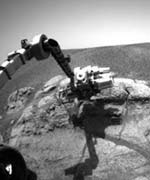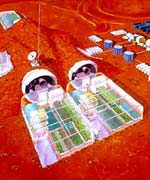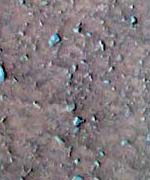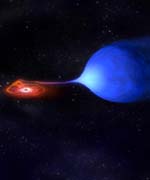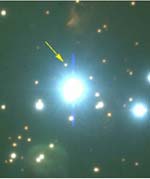
Image credit: CfA
Since its discovery in 1998, the “winking star” called KH 15D has baffled astronomers seeking to explain its long-lasting (24-day) eclipses. Many hypothesized that the eclipses were caused by intervening blobs of material within a protoplanetary disk surrounding a single, young Sun-like star.
By examining the past history of these eclipses and how they are changing with time, astronomer Joshua Winn (Harvard-Smithsonian Center for Astrophysics) and colleagues have overturned this hypothesis and devised a new theory that explains nearly everything about the system.
They found that the “winking star” is actually a double star system. Something in the foreground, possibly a dusty disk of material surrounding the binary, intermittently blocks the light from one or both stars, as the stars orbit each other. Eventually, both stars will be completely covered by the dust curtain, and the “winking star” system will disappear from view.
“These two stars have been playing hide and seek with us. The second star used to peek out briefly, but now is completely obscured. Soon, it will be joined by the first star and both will remain hidden for decades,” says Winn.
Archives Reveal The Truth
The vital clues to understanding the “winking star” were found in archival sky photographs from Harvard College Observatory, in Massachusetts, and Asiago Observatory, in Italy. Examination of the Harvard photographs showed that during the first half of the 20th century, there were none of the total eclipses that are observed today. Asiago photographs taken between 1967 and 1982 held evidence of eclipses, but with a key difference: the system was brighter than it is today, both during eclipses and outside of eclipses. This extra light must have come from a second star that was visible in the 1970s, but is completely hidden today.
This insight was the key to unlocking the mystery of KH 15D. Before 1960, neither star was being eclipsed. Then, a curtain of dust drifted into the foreground as seen from the Earth, blocking part of the orbit of one of the stars. Throughout the 1970s, that star underwent eclipses as its orbital motion carried it behind the curtain. By 1998, the curtain had advanced enough to completely hide one of the stars-and the other star periodically drops out of sight as its orbit takes it behind the curtain. By about 2012, both stars will be completely hidden from view.
Radial velocity measurements currently being made by John Johnson (UC Berkeley), a co-author of this study, will be able to test whether the visible star is moving back and forth, tugged by the gravity of a stellar-mass companion.
“The Asiago plates give very convincing evidence, but the radial velocity measurements will be the clincher,” says Johnson.
The New Picture of KH 15D
Assembling the observations of KH 15D like pieces of a jigsaw puzzle reveals two stars no older than 10 million years. (Our Sun, by contrast, is 5 billion years old.) They revolve around each other every 48 days in highly elliptical orbits, which explains the 48-day eclipse period. Their average distance apart is approximately 0.25 astronomical units (23 million miles), or two-thirds the distance from Mercury to the Sun. Yet their eccentric orbits take them as close to each other as only 0.07 AU (6.5 million miles).
“As binaries go, their orbit is not unusual” says co-author Krzysztof Stanek (CfA).
Winn agrees, adding, “The weird thing about this system is that there’s something blocking the light from these stars-something opaque, with a sharp edge.” The identity of this curtain is unknown, but it may be the edge of a disk of dust that surrounds both of the stars.
“Dust disks have been seen around other binary star systems,” says Matthew Holman (CfA), a co-author of the study. “We imagine that the disk in this system is inclined, relative to the plane of the orbit of the two stars. That would cause the disk to wobble, the way a Frisbee sometimes wobbles in the air after a bad throw.”
According to Holman’s calculations, the dust may exist in a ring located 2.6 AU (240 million miles) from the stars. The material in the ring itself makes one complete orbit about every 4 years, but the wobbling (or “precession”) of the ring has a much longer period of about 1000 years. A similar theory has been proposed independently by Eugene Chiang and Ruth Murray-Clay of UC Berkeley.
“Starting around 1960, the edge of this precessing disk happened to start blocking our view of the stars,” says Holman. “After another decade, the disk will precess a little further and completely block our view.” Some time after that, depending on how thick the ring is, the process will reverse itself as the stars are gradually uncovered, and the eclipses will stop.
Many questions about KH 15D still remain. For example, what is the nature of the disk? Why is it inclined to the orbital plane of the binaries? Why does it have such a sharp edge? The winking stars of KH 15D are likely to confound astronomers with these and other riddles for years to come.
This research will be published in the March 1, 2004 issue of The Astrophysical Journal Letters. The authors of the study are Joshua Winn (CfA), Matthew Holman (CfA), John Johnson (UC Berkeley), Krzysztof Stanek (CfA), and Peter Garnavich (University of Notre Dame).
Headquartered in Cambridge, Mass., the Harvard-Smithsonian Center for Astrophysics is a joint collaboration between the Smithsonian Astrophysical Observatory and the Harvard College Observatory. CfA scientists, organized into six research divisions, study the origin, evolution and ultimate fate of the universe.
Original Source: CfA News Release

